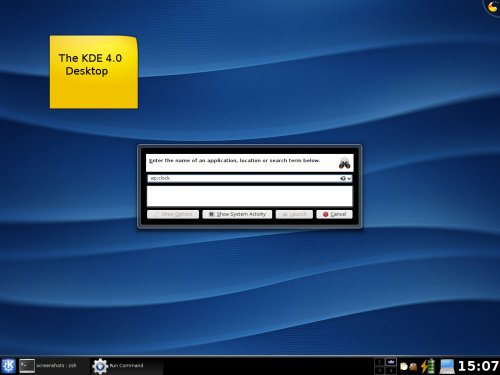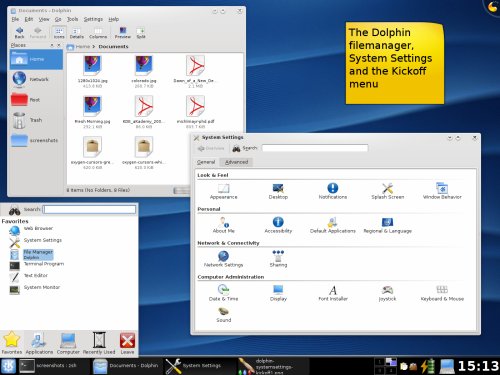KDE 4.0 Released
KDE Project Ships Fourth Major Version of cutting edge Free Software Desktop
With the fourth major version, the KDE Community marks the beginning of the KDE
4 era.
January 11, 2008 (The INTERNET).
The KDE Community is thrilled to announce the immediate availability of KDE 4.0
[ http://www.kde.org/announcements/4.0/ ]. This significant release marks both the
end of the long and intensive development cycle leading up to KDE 4.0 and the beginning
of the KDE 4 era.

The KDE 4.0 desktop
The KDE 4 Libraries have seen major improvements in almost all areas. The Phonon
multimedia framework provides platform independent multimedia support to all KDE
applications, the Solid hardware integration framework makes interacting with (removable)
devices easier and provides tools for better power management.
The KDE 4 Desktop has gained some major new capabilities. The Plasma desktop
shell offers a new desktop interface, including panel, menu and widgets on the desktop
as well as a dashboard function. KWin, the KDE Window manager, now supports advanced
graphical effects to ease interaction with your windows.
Lots of KDE Applications have seen improvements as well. Visual updates through
vector-based artwork, changes in the underlying libraries, user interface enhancements,
new features, even new applications -- you name it, KDE 4.0 has it. Okular, the
new document viewer and Dolphin, the new file manager are only two applications
that leverage KDE 4.0's new technologies.
The Oxygen Artwork team provides a breath of fresh air on the desktop. Nearly
all the user-visible parts of the KDE desktop and applications have been given a
facelift. Beauty and consistency are two of the basic concepts behind Oxygen.
Desktop
- Plasma is the new desktop shell. Plasma provides a panel, a menu and other
intuitive means to interact with the desktop and applications.
- KWin, KDE's proven window manager, now supports advanced compositing features.
Hardware accelerated painting takes care of a smoother and more intuitive interaction
with windows.
- Oxygen is the KDE 4.0 artwork. Oxygen provides a consistent, easy on the
eye and beautiful artwork concept.
Learn more about KDE's new desktop interface in the KDE 4.0 Visual Guide [ http://www.kde.org/announcements/4.0/guide.php
].
Applications
- Konqueror is KDE's established web browser. Konqueror is light-weight, well
integrated, and supports the newest standards such as CSS 3.
- Dolphin is KDE's new file manager. Dolphin has been developed with usability
in mind and is an easy-to-use, yet powerful tool.
- With System Settings, a new control center interface has been introduced.
The KSysGuard system monitor makes it easy to monitor and control system resources
and activity.
- Okular, the KDE 4 document viewer, supports many formats. Okular is one
of the many KDE 4 applications that has been improved in collaboration with
the OpenUsability Project [ http://openusability.org ].
- Educational Applications are among the first applications that have been
ported and developed using KDE 4 technology. Kalzium, a graphical periodic table
of elements and the Marble Desktop Globe are only two of many gems among the
educational applications. Read more about Educational Applications in the Visual
Guide [ http://www.kde.org/announcements/4.0/education.php ].
- Lots of the KDE Games have been updated. KDE Games such as KMines, a minesweeper
game and KPat, a patience game have had facelifts. Thanks to new vector artwork
and graphical capabilities, the games have been made more resolution independent.
Some applications are introduced in more detail in the KDE 4.0 Visual Guide [ http://www.kde.org/announcements/4.0/applications.php
].

Filemanager, System Settings and Menu in action
Libraries
- Phonon offers applications multimedia capabilities such as playing audio
and video. Internally, Phonon makes use of various backends, switchable at runtime.
The default backend for KDE 4.0 will be the Xine backend supplying outstanding
support for various formats. Phonon also allows the user to choose output devices
based on the type of multimedia.
- The Solid hardware integration framework integrates fixed and removable
devices into KDE applications. Solid also interfaces with the underlying system's
power management capabilities, handles network connectivity and integration
of Bluetooth devices. Internally, Solid combines the powers of HAL, NetworkManager
and the BlueZ bluetooth stack, but those components are replacable without breaking
applications to provide maximum portability.
- KHTML is the webpage rendering engine used by Konqueror, KDE's web browser.
KHTML is light-weight and supports modern standards such as CSS 3. KHTML was
also the first engine to pass the famous Acid 2 test.
- The ThreadWeaver library, which comes with kdelibs, provides a high-level
interface to make better use of today's multi-core systems, making KDE applications
feel smoother and more efficiently using resources available on the system.
- Being built on Trolltech's Qt 4 library, KDE 4.0 can make use of the advanced
visual capabilities and smaller memory footprint of this library. kdelibs provides
an outstanding extension of the Qt library, adding large amounts of high-level
functionality and convenience to the developer.
KDE's TechBase [ http://techbase.kde.org ] knowledge library has more information
about the KDE libraries.
Take a guided tour...
The KDE 4.0 Visual Guide [ http://www.kde.org/announcements/4.0/guide.php ] provides
a quick overview of various new and improved KDE 4.0 technologies. Illustrated with
many screenshots, it walks you through the different parts of KDE 4.0 and shows
some of the exciting new technologies and improvements for the user. New features
of the desktop [ http://www.kde.org/announcements/4.0/desktop.php ] get you started,
applications [ http://www.kde.org/announcements/4.0/applications.php ] such as System
Settings, Okular the document viewer and Dolphin the file manager are introduced.
Educational applications [ http://www.kde.org/announcements/4.0/education.php ]
are shown as well as Games [ http://www.kde.org/announcements/4.0/games.php ].
Give it a spin...
For those interested in getting packages to test and contribute, several distributions
have notified us that they will have KDE 4.0 packages available at or soon after
the release. The complete and current list can be found on the KDE 4.0 Info Page
[ http://www.kde.org/info/4.0.php ], where you can also find links to the source
code, information about compiling, security and other issues.
The following distributions have notified us of the availability of packages
or Live CDs for KDE 4.0:
- An alpha version of KDE4-based Arklinux 2008.1 is expected shortly after
this release, with an expected final release within 3 or 4 weeks.
- Debian KDE 4.0 packages are available in the experimental branch. The KDE
Development Platform will even make it into Lenny. Watch for announcements by
the Debian KDE Team [ http://pkg-kde.alioth.debian.org/ ]. Rumours are that
a Live CD is planned as well.
- Fedora will feature KDE 4.0 in Fedora 9, to be released [ http://fedoraproject.org/wiki/Releases/9
] in April, with Alpha releases being available from 24th of January. KDE 4.0
packages are in the pre-alpha Rawhide [ http://fedoraproject.org/wiki/Releases/Rawhide
] repository.
- Gentoo Linux provides KDE 4.0 builds on http://kde.gentoo.org.
- Kubuntu packages are included in the upcoming "Hardy Heron" (8.04) and also
made available as updates for the stable "Gutsy Gibbon" (7.10). A Live CD is
available for trying out KDE 4.0. More details can be found in the announcement
on Kubuntu.org [ http://kubuntu.org/announcements/kde-4.0.php ].
- Mandriva will provide packages for 2008.0 [ http://download.kde.org/binarydownload.html?url=/stable/4.0.0/Mandriva/
] and aims at producing a Live CD with the latest snapshot of 2008.1.
- openSUSE packages are available [ http://en.opensuse.org/KDE/KDE4 ] for
openSUSE 10.3 (one-click install [ http://download.opensuse.org/repositories/KDE:/KDE4:/STABLE:/Desktop/openSUSE_10.3/KDE4-BASIS.ymp
] ), openSUSE Factory (one-click install [ http://download.opensuse.org/repositories/KDE:/KDE4:/STABLE:/Desktop/openSUSE_Factory/KDE4-BASIS.ymp
] ) and openSUSE 10.2. A KDE Four Live CD [ http://home.kde.org/~binner/kde-four-live/
] with these packages is also available. KDE 4.0 will be part of the upcoming
openSUSE 11.0 release.
About KDE 4
KDE 4.0 is the innovative Free Software desktop containing lots of applications
for every day use as well as for specific purposes. Plasma is a new desktop shell
developed for KDE 4, providing an intuitive interface to interact with the desktop
and applications. The Konqueror web browser integrates the web with the desktop.
The Dolphin file manager, the Okular document reader and the System Settings control
center complete the basic desktop set.
KDE is built on the KDE Libraries which provide easy access to resources on the
network by means of KIO and advanced visual capabilities through Qt4. Phonon and
Solid, which are also part of the KDE Libraries add a multimedia framework and better
hardware integration to all KDE applications.
About KDE
KDE is an international technology team that creates free and open source software
for desktop and portable computing. Among KDE's products are a modern desktop system
for Linux and UNIX platforms, comprehensive office productivity and groupware suites
and hundreds of software titles in many categories including Internet and web applications,
multimedia, entertainment, educational, graphics and software development. KDE software
is translated into more than 60 languages and is built with ease of use and modern
accessibility principles in mind. KDE4's full-featured applications run natively
on Linux, BSD, Solaris, Windows and Mac OS X.
Trademark Notices. KDE® and the K Desktop Environment® logo are registered trademarks
of KDE e.V. Linux is a registered trademark of Linus Torvalds. UNIX is a registered
trademark of The Open Group in the United States and other countries. All other
trademarks and copyrights referred to in this announcement are the property of their
respective owners.

